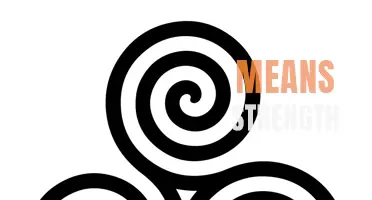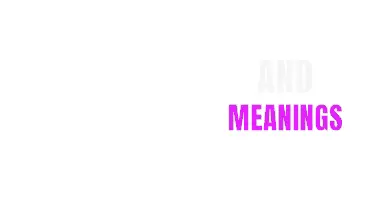
Throughout history, the heart has been universally regarded as a symbol of love, passion, and emotion. As the center of our being, both physically and metaphorically, the heart has come to represent the depth of our feelings and the power of our connections with others. From ancient civilizations to modern times, hearts can be found in art, literature, and even in our daily lives, reminding us of the profound significance of love and the incredible capacity of our hearts to both give and receive it. Whether seen as a romantic symbol or a representation of compassion and empathy, the heart is a timeless emblem that resonates with people of all cultures and walks of life.
What You'll Learn
- What is the history behind the heart symbol and its meaning?
- How has the meaning of the heart symbol evolved over time?
- In which cultures or religions is the heart symbol commonly used and what does it symbolize in each?
- Are there any specific colors or variations of the heart symbol that hold different meanings?
- How is the heart symbol used in literature, art, or other forms of creativity to convey deeper meanings or emotions?

What is the history behind the heart symbol and its meaning?
The heart symbol is one of the most recognized and widely used symbols in the world today. It is engraved on jewelry, used in art, and even used to express emotions and affection. But have you ever wondered about the history behind this symbol and its meaning?
The origins of the heart symbol can be traced back to ancient times. Many believe that the heart symbol originated from the ancient Egyptians, who associated the heart with the center of emotional and intellectual intelligence. The Egyptians believed that the heart was the organ responsible for all thoughts and emotions, rather than the brain. They also believed that the heart was the seat of the soul and the source of life.
The heart symbol gained further significance during ancient Greek and Roman times. The Greeks believed that the heart was the center of all human emotions, including love and desire. They also associated the heart with the goddess Aphrodite, who was the goddess of love, beauty, and fertility. The Romans adopted this symbolism and associated the heart symbol with their goddess of love, Venus.
During the Middle Ages, the heart symbol took on a new meaning. It became associated with the concept of romantic love, as depicted in the famous medieval tale of Sir Gawain and the Green Knight. In this story, the heart symbol was used to represent love and fidelity. It was often depicted as a heart pierced by an arrow, symbolizing the pain and passion of love.
The heart symbol as we know it today started to gain popularity during the 18th and 19th centuries. It was during this time that the heart symbol became popularized as a symbol of love and affection. It was commonly used in love letters, poems, and romantic art. The heart symbol was also frequently depicted in jewelry, such as lockets and rings, as a token of love and devotion.
In modern times, the heart symbol has taken on even more meanings. It is now widely recognized as a symbol of love, compassion, and care. It is used to express affection towards loved ones or to convey support and empathy. The heart symbol has become a universal symbol that transcends cultural and language barriers.
In conclusion, the heart symbol has a rich history and meaning that dates back to ancient times. From its origins in ancient Egypt to its association with love and romance during medieval times, the heart symbol has always been connected to emotions and the human experience. Today, the heart symbol is widely recognized as a symbol of love and compassion, and it continues to be used to express emotions and affection in various forms of art and communication.
The Deep and Symbolic Meaning Behind Rammstein's Iconic Symbol
You may want to see also

How has the meaning of the heart symbol evolved over time?
The heart symbol is one of the most easily recognizable symbols in the world. It is often associated with love, affection, and emotions. However, the meaning of the heart symbol has evolved over time and has different interpretations in different cultures.
The origins of the heart symbol can be traced back to ancient times. It is believed to have first appeared in the 13th century, during the medieval period. At first, the heart symbol was associated with courage, bravery, and vitality. It was seen as the center of human emotions and the source of one's strength. In medieval artwork, the heart symbol was often depicted as a stylized heart shape with a deep cleft in the middle, representing the heart's ventricles.
During the Renaissance period, the heart symbol gradually began to be associated with romantic love and passion. Artists and poets of the time embraced the heart symbol as a way to express their deep emotions and feelings. It became a popular motif in love letters, valentine's cards, and romantic literature. The heart symbol was also often depicted with arrows to symbolize the pain and desire of love.
In the 18th and 19th centuries, the heart symbol became more commonly associated with romantic love and affection. It started to appear in jewelry, especially in the form of heart-shaped lockets and pendants. The heart symbol also became a popular motif in decorative arts and design, appearing in paintings, sculptures, and textiles.
In recent times, the heart symbol has taken on a broader meaning. It is not only associated with romantic love but also with compassion, kindness, and empathy. The heart symbol has become a universal symbol of love and care, transcending cultural and linguistic barriers. It is often used as a logo for charities and organizations that promote love and care for others.
Today, the heart symbol is used in various contexts and interpretations. It can represent romantic love, friendship, family bonds, or a general sense of love and compassion. It is often used in social media posts, tattoos, and artwork to convey deep emotions and feelings.
In conclusion, the meaning of the heart symbol has evolved over time. From its origins as a symbol of courage and vitality, it has transformed into a symbol of romantic love and affection. In modern times, the heart symbol represents love, compassion, and care in its various interpretations. It remains a powerful and universally recognized symbol that continues to hold deep meaning for people around the world.
Unraveling the Hidden Meanings: Decoding the Symbols of Freedom
You may want to see also

In which cultures or religions is the heart symbol commonly used and what does it symbolize in each?
The heart symbol is universally recognized as a symbol of love and affection. However, its meaning can vary depending on the cultural or religious context in which it is used. In this article, we will explore the use and symbolism of the heart symbol in different cultures and religions.
In Western culture, the heart symbol has long been associated with love and romance. It is commonly used to represent deep affection, passion, and emotional attachment. It is often used in Valentine's Day cards, marriage proposals, and other expressions of love. In this context, the heart symbol embodies the idea of love as a strong emotion that connects two people.
In Christianity, the heart symbol has a deeper spiritual meaning. It is often depicted as a sacred heart, surrounded by thorns and flames. This symbol represents the heart of Jesus Christ, which is believed to be full of love and compassion for humanity. The flames symbolize the burning love of Christ, while the thorns represent the suffering he endured for the sake of humanity's salvation. The sacred heart symbol is often used in religious art and is considered a source of comfort and inspiration for believers.
In Hinduism, the heart symbol has a different connotation. It is associated with the concept of "Anahata," which means "unstruck" or "unhurt" in Sanskrit. The heart chakra, located in the center of the chest, is believed to be the seat of unconditional love and compassion. The heart symbol is often used to represent the opening and activation of this chakra, leading to a deeper connection with oneself and others. It is also seen as a symbol of emotional balance, harmony, and spiritual growth.
In Buddhism, the heart symbol is associated with the teachings of loving-kindness and compassion. It is often used as a reminder to cultivate a kind and compassionate heart towards all beings. This symbolizes the aspiration to overcome selfishness and develop a genuine concern for the well-being of others. The heart symbol is also used in Buddhist art to represent the enlightened heart of the Buddha, which is free from attachments and filled with boundless love and compassion.
In Islamic culture, the heart symbol has a spiritual significance. It is associated with the concept of "Qalb," which means "heart" in Arabic. In Islamic mysticism, the heart is considered the seat of the soul and the center of spiritual awareness. The heart is believed to be the place where one can directly experience and connect with the divine. The heart symbol is often used as a reminder to turn inward and cultivate a pure and sincere heart in order to attain spiritual enlightenment.
In conclusion, the heart symbol is used in various cultures and religions to represent love, compassion, and spiritual awareness. Its meaning may differ slightly in each context, but its essence remains the same—a symbol of deep and profound emotional connection. Whether used in the context of romance, spirituality, or personal growth, the heart symbol serves as a universal reminder of the power of love and the importance of cultivating a compassionate heart.
Understanding the Meaning of Whirlpool 6th Sense Washing Machine Symbols
You may want to see also

Are there any specific colors or variations of the heart symbol that hold different meanings?
The heart symbol is one of the most iconic and widely recognized symbols in the world. It is often associated with love, affection, and romance. However, did you know that there are specific colors or variations of the heart symbol that hold different meanings? In this article, we will explore the various colors and variations of the heart symbol and their corresponding connotations.
- Red Heart: The red heart is the most commonly used and recognized variation of the heart symbol. It universally represents love, passion, and affection. It is often used to express romantic love or deep affection towards someone.
- Pink Heart: The pink heart symbolizes love, tenderness, and friendship. It is often used to represent affectionate and caring love, such as the love between family members or close friends. It also embodies compassion and empathy.
- Blue Heart: The blue heart is associated with calmness, loyalty, and trust. It can symbolize deep and stable emotions, such as the love between long-term partners or the bond between siblings. It is often used to express trustworthiness and sincerity.
- Purple Heart: The purple heart is associated with spirituality, creativity, and luxury. It often represents a deep connection or bond with someone. It can be used to express admiration, gratitude, or to symbolize a deep and profound love.
- Yellow Heart: The yellow heart symbolizes friendship, joy, and happiness. It is often used to express a positive and light-hearted love, such as the love between close friends or the love for life itself. It carries connotations of optimism, positivity, and cheerfulness.
- Green Heart: The green heart represents nature, growth, and harmony. It is often used to symbolize a healthy and balanced love for oneself, others, and the environment. It carries connotations of renewal, freshness, and fertility.
- Black Heart: The black heart, contrary to its color, does not represent negativity or bad intentions. Instead, it symbolizes deep and intense emotions, such as grief, sorrow, or a broken heart. It is often used to express deep sadness or a mourning period.
- White Heart: The white heart symbolizes purity, innocence, and spirituality. It is often used to convey a pure and unconditional love, such as the love between soulmates or a spiritual connection with a higher power. It carries connotations of divinity and enlightenment.
It is important to note that these color associations are not set in stone and can vary depending on cultural and personal interpretations. However, these general connotations can help provide a deeper understanding of the different emotions and meanings that can be conveyed through the heart symbol in its various colors and variations.
In conclusion, while the heart symbol is primarily associated with love, affection, and romance, the different colors and variations can convey specific meanings and emotions. From the passionate red heart to the calm blue heart, each color holds its own significance. Whether you use the heart symbol to express romantic love, friendship, trust, or spirituality, understanding the various connotations can help enhance your communication and expression of emotions.
Decoding the Hidden Symbolism of Airplanes: Exploring the Meaning Behind Aircraft Imagery
You may want to see also

How is the heart symbol used in literature, art, or other forms of creativity to convey deeper meanings or emotions?
The heart symbol is one of the most recognizable and enduring symbols in art, literature, and other forms of creativity. It is often used to convey deeper meanings or evoke strong emotions. Whether it is used to represent love, passion, or the essence of the human spirit, the heart symbol has a powerful ability to resonate with people on a profound level.
In literature, the heart symbol is commonly used to represent love and affection. It can be found in romantic poetry, love letters, and famous works of literature throughout history. For example, in William Shakespeare's "Romeo and Juliet," the heart symbol is used to convey the intensity of the love between the two star-crossed lovers. Juliet famously proclaims, "My bounty is as boundless as the sea, My love as deep; the more I give to thee, The more I have, for both are infinite." This quote not only captures the depth of Juliet's love for Romeo, but also the boundless nature of love itself.
In art, the heart symbol is often used to represent emotions and the human experience. It can be seen in paintings, sculptures, and other forms of visual art. One famous example is Gustav Klimt's painting, "The Kiss," in which two lovers embrace with their bodies forming the shape of a heart. This painting not only depicts a passionate moment between two individuals, but also captures the essence of love and connection.
The heart symbol is also used in various forms of creativity to convey deeper meanings and represent the human spirit. In religious and spiritual contexts, the heart symbol is often associated with the soul or innermost being. It is seen as a symbol of purity, divinity, and love. This can be seen in religious artwork and symbolism, where the heart is often depicted with wings or a halo to represent its transcendent nature.
Furthermore, the heart symbol is used in modern culture as a way to convey emotions and sentiments. It is widely used in greeting cards, advertisements, and social media to express love, affection, and compassion. The heart emoji, for example, is one of the most commonly used emojis and is used to convey a variety of emotions, from love to friendship to gratitude.
In conclusion, the heart symbol is a powerful and universal symbol that is used in literature, art, and other forms of creativity to convey deeper meanings and evoke strong emotions. Whether it is used to represent love, passion, or the essence of the human spirit, the heart symbol has a timeless and enduring quality that resonates with people on a profound level. It is a symbol that speaks to the universal nature of human emotions and experiences, and its use in various forms of creativity will continue to inspire and move people for generations to come.
Understanding Thermostat Symbols and Their Meaning
You may want to see also
Frequently asked questions
Answer: The heart is a universal symbol that represents love, emotion, and compassion. It is often associated with romantic love, but its meaning extends beyond that. The heart symbolizes deep emotions, connection, and the essence of being.
Question: Why is the heart associated with love?
Answer: The association of the heart with love can be traced back to ancient cultures. The heart was considered the center of the soul, and love was believed to originate from the heart. This belief has been passed down through generations, and today, the heart is a widely recognized symbol of love and affection.
Question: What other meanings does the heart symbol have?
Answer: In addition to love, the heart symbol also represents emotions, relationships, and unity. It can symbolize passion, desire, and the intensity of emotions. It is often used to convey empathy, kindness, and care for others. The heart symbol can also be seen as a symbol of life and vitality, as the heart is vital organ that sustains our existence.







